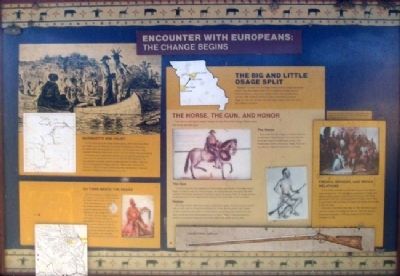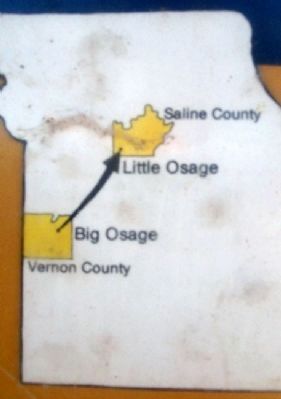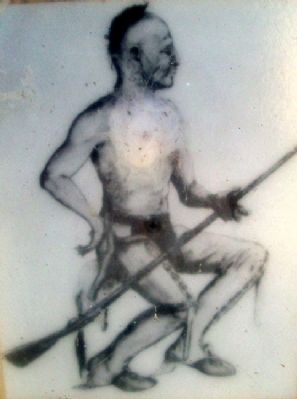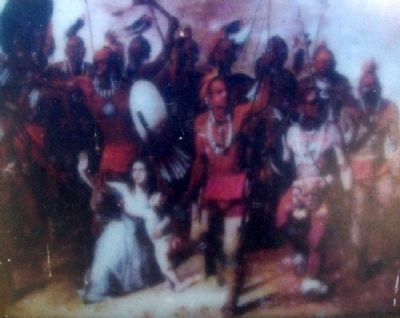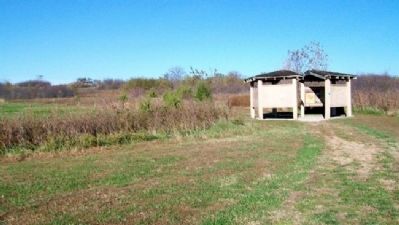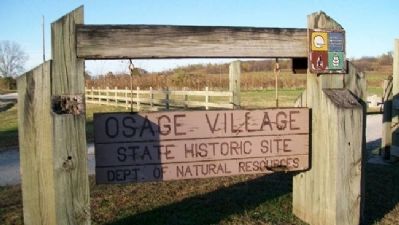Near Fair Haven in Vernon County, Missouri — The American Midwest (Upper Plains)
Encounter With Europeans: The Change Begins
Inscription.
Marquette and Joliet
The first reference to the Osage Indians was in 1673 when Louis Joliet and Father Jacques Marquette descended the Mississippi River from the Great Lakes and stopped at the mouth of the Missouri River. They collected information about tribes on the river from Indians they encountered.
The French soon established themselves in the area. Missionaries built missions on the Illinois River and later at Cahokia and Kaskaskia. The first explorers to actually meet the Osage were the fur traders. They may have encountered the Osage as early as 1680 but did not leave any records. In 1693, two French traders reportedly reached the Osage and returned to Kaskaskia with members of the tribe.
Du Tisne Meets The Osage
The first European to visit the Osage and leave a record was Charles Claude du Tisne. In the summer of 1719, du Tisne left Kaskaskia and reached the Big Osage village located "o[illegible] eminence about one and one-[illegible] leagues from the Osage River."
Du Tisne said the village consisted of 100 lodges and 200 warriors. He described the Osage as well built and having several chiefs from different [illegible], although they had little power. [He? f]ound them difficult to deal with, but [the?] chiefs treated him hospitably [beca]use they wanted to trade with him.
The Big and Little Osage Split
Between 1714 and 1719, the Osage Indians split into larger and smaller groups. The Little Osage moved north to establish a village near the Missouri Indians in what is now Saline County. They remained there until the 1780s. When the Missouri Indians, decimated by disease, began to move from the area, the Little Osage began to turn more to the Big Osage for protection.
The Horse, The Gun, And Honor
Two items that had a major impact on the life of the Osage Indian were the horse and the gun.
The Horse
About 1630, the horse began to spread north from the Spanish in New Mexico. It took many years for the horse to reach the plains area, but by 1700, horses were common among the Osage. The horse permitted the Osage to move farther and faster.
The Gun
The other important item supplied by the Europeans was the gun. The Osage quickly began to trade furs with the French for guns. As long as they had more guns than their neighbors, the Osage maintained a dominant position. Because of this, the Osage became the fiercest group on the eastern plains and the most sought after by the fur traders.
Honor
The Osage and the other plains tribes established a pattern of warfare and honor that today is often used to characterize the American Indian. But this pattern
was created by items supplies by Europeans. For the Indians, acts of daring that placed life at risk were considered manly and bestowed honor on the individual. It was impossible for settlers to understand these acts and so the settlers and Indians were at odds.
French, Spanish, and Indian Relations
As the Osage acquired more horses and guns, they became more dominant. By 1733, reports abounded that the Osage were attacking other groups of Indians and Frenchmen. The French government, with only a small population of traders, tried to stay on good terms with the Indians to support the traders and did little to stop the raids.
At the end of the Seven Years War in 1763, the French signed over the Louisiana Territory to the Spanish. When the Spanish finally took possession of the area, treatment of the Indians changed very little.
Topics. This historical marker is listed in these topic lists: Colonial Era • Exploration • Native Americans • Settlements & Settlers • Waterways & Vessels. A significant historical year for this entry is 1673.
Location. 37° 58.877′ N, 94° 12.537′ W. Marker is near Fair Haven, Missouri, in Vernon County. Marker is in the kiosk located about 300 feet northeast of the parking lot at Osage Village State Historic Site, off Road C, about 2 miles west of Fair Haven.
Touch for map. Marker is in this post office area: Harwood MO 64750, United States of America. Touch for directions.
Other nearby markers. At least 8 other markers are within 12 miles of this marker, measured as the crow flies. The Osage and the Fur Trade (here, next to this marker); The Osage Indians (here, next to this marker); Changing Life Styles (here, next to this marker); Archaeology (here, next to this marker); Osage Sites in the Area (about 600 feet away, measured in a direct line); Harmony Mission (approx. 11.2 miles away); The Town That Coal Built (approx. 11˝ miles away); Veterans Memorial (approx. 12 miles away). Touch for a list and map of all markers in Fair Haven.
Also see . . .
1. Osage Village State Historic Site, Missouri. Missouri State Parks website entry (Submitted on November 25, 2012, by William Fischer, Jr. of Scranton, Pennsylvania.)
2. The Osage Nation. Website homepage (Submitted on November 25, 2012, by William Fischer, Jr. of Scranton, Pennsylvania.)
Credits. This page was last revised on May 23, 2022. It was originally submitted on November 25, 2012, by William Fischer, Jr. of Scranton, Pennsylvania. This page has been viewed 479 times since then and 21 times this year. Photos: 1, 2, 3, 4, 5. submitted on November 25, 2012, by William Fischer, Jr. of Scranton, Pennsylvania. 6. submitted on March 16, 2011, by William Fischer, Jr. of Scranton, Pennsylvania.
